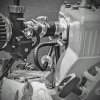How do I know? I put this Nibbi on a 2hp Briggs flathead. But it's way too much carb for that. The slide is so short and fat it may as well be an on/off switch for air fuel mix. It's just all or nothing with this '"racing" carburetor. So here I had an aperture that's huge, and an engine that's tiny. The Nibbi is designed for moving high-rpm-amounts of air but the 2hp Briggs is supposed to idle around 1750 and max out around 3600rpm. But like a knucklehead I went ahead and tried to make it work, and it does – after plenty of reading all about needles, and finally accepting the marriage for what it is.
Like I said it's all or nothing with this carb.... Twist the throttle just a little bit and the aperture opens so wide that air pressure in the carb and manifold just dropped dead, and the engine would just gasp and stumble along until you got going at a decent clip. It was a mismatch from the start...and the block's intake port is even something like 5mm smaller than the carb's output port at the flange. I tapered this with a diy manifold the best I could, and thoroughly tested for the best possible main (118) and pilot jets (42). But the problem remained that the stock needle wouldn't allow enough fuel to counter the massive amount of air suddenly available when the throttle opens. Plus I was having to baby it the whole time. The little 100cc engine just doesn't have the suction power to pull the air through the carb with enough velocity to then pull fuel up out of the needle's housing/hole (aka needle jet/emulsion tube). Not at lower rpms anyway. So I determined I could affect this by changing to a richer needle ...like one that's nearly leaking at idle.
This isn't meant to be a lesson in slide carb theory, as I'm certainly no expert, but suffice it to say needles vary in widths, taper angles and other characteristics, and allow you to enrich or lean out the mixture for various points along the range of throttle twist, and when the slide raises to let more air in the needle starts coming out of its hole and letting gas start coming up, right? So a richer needle is a skinnier needle, and one with a taper/angle that meters gas flow to be either heavy from the start or heavier toward mid- or WOT, or what have you... And my theory was the skinnier the better for the flathead's just beginning to spin up out of its idle rpms.
So while the stock Nibbi needle appeared to be one-size-fits-all, I ultimately found the Keihins mentioned above were the right size and came with a robust variety of needle shapes and sizes within that Keihin PE26/28 category.
The needle I've settled on (
46-HFF 017-617) offers a nice rich mix right out of the gates, followed by a slow increase in flow so the mixture hits the spot and both engine and carb respond to each other nicely.
View attachment 301927



